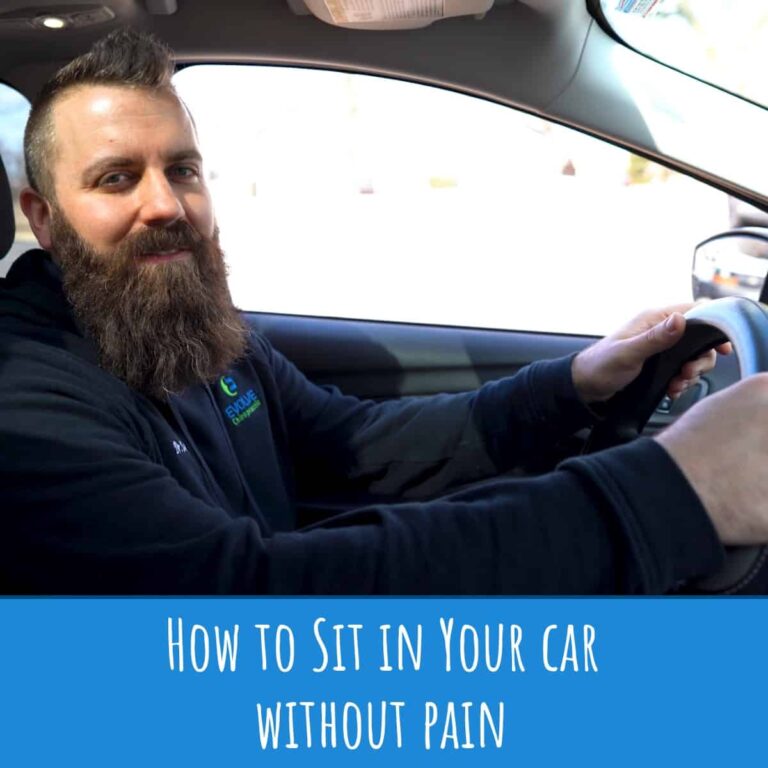Have you ever sat in a car and felt pain, discomfort, or stress? A lousy driving posture can put unnecessary strain on your back, neck, and shoulders, which can result in feeling a ton of pain while driving. Maybe you tend to sit with your head over the wheel to see what’s ahead of you or slouch down to find a more comfortable position while driving. Unfortunately, both of these positions will eventually cause discomfort instead of providing the relief you need.
We all know that sitting in a car for long periods of time can put pressure on your back and cause pain. However, most of us don’t understand that how we sit in a car is the biggest reason we feel this discomfort! If you want to reduce your pain, stop slouching, and find a more comfortable way to sit in the car, you’ll need to learn how to sit properly in a car seat the correct way. Continue reading to learn everything you need to know to take care of yourself while driving.
Why Does My Driving Posture Matter?
The way you sit in your car seat can make a huge difference in how comfortable and pain-free your ride will be. If you slouch or hold a rigid position, you’ll be putting painful pressure on certain parts of your body such as your neck, back, and legs. When this stress builds up, it creates unnecessary fatigue and pain to the point that you may need professional help from a chiropractor to alleviate your symptoms.
Even short trips with poor posture can gradually lead to muscle imbalances and joint stiffness – your body doesn’t reset after each drive; it accumulates stress over time. Posture also affects how well your lungs expand and how efficiently your blood circulates. A slouched position can reduce oxygen intake and increase fatigue behind the wheel. Research shows that poor sitting posture while driving contributes to a higher rate of lumbar disc injuries and soft tissue strain. Continuous slumping can cause spinal misalignment and even nerve compression in the lower back.
Thankfully, you can easily avoid this pain and fatigue by finding the proper driving posture.
What Is The Correct Driving Seat Position?
While you might not think too much about how you sit in your car every time you drive, spending just a few minutes adjusting your driving can have a huge impact on your health.
While every person will need to make their own adjustments depending on their weight and height, at Evolve Chiropractic, we’ve broken this process down to help make sure you’re sitting in the correct driving seat position.
- Start With Your Seat Height
First, you’ll want to ensure that your seat height is appropriately adjusted so that you can see the road, your car’s dashboard, and your mirrors without straining your neck. This is important because the height of your seat can impact the amount of strain we put on our bodies, especially if it’s too high or too low of a height.
Very tall drivers may benefit from lowering the seat as far as it goes and reclining slightly to avoid ceiling clearance issues, while shorter drivers might need a seat booster to maintain eye level with the road and proper contact with pedals.
When you have a proper seat height, you won’t need to slump over the front of your steering wheel or reach up to meet your steering wheel. The right seat height will allow your feet to sit flat on the floor. If you still can’t attain the perfect height after you’ve adjusted your seat height, you can always include a cushion for extra support.
- Adjust The Seat Position
You’ll want to adjust your seat position, including how forward, back, or tilted your car seat is sitting to help find the correct driving position posture. You’ll want to move the seat forward enough to extend your legs while still keeping a slight bend of the knees.
Make sure that both feet can easily touch the gas and brake pedals while being able to shift between the two as needed. If you’re having issues reaching the pedals or you’re too far over the pedals, you’ll need to re-adjust your seat. Keep the incline of your seat upright with a slight recline. You want to make sure your back is comfortable and supported, not forced into an uncomfortable straight-back position. The right seat position will make it easier to support your weight without putting too much pressure on any part of your body.
For optimal support, aim for a seatback angle of approximately 100–110 degrees. This helps reduce lower back pressure without compromising control. If your car seat doesn’t provide ideal tilt, a small wedge cushion can help adjust your pelvic angle to maintain spinal alignment.
- Find The Right Back Support
Back support is essential to make sure you have the best car seat position to help with any lower back pain. While maintaining the proper leg placement, you’ll want to ensure your seat is adjusted so that your back can slide all the way back into the seat, offering support and comfort to your spine.
If you have lumbar support in your car, use it to help support your spine. In newer cars, you’re able to adjust the depth and height of your lumbar support to help you find a comfortable, supported position. Wondering if you have the right position? Think about the curve in your spine if you were to sit with your back flat in a straight chair. The part where your spine would naturally curve is the ideal position you would want to put your lumbar support.
While some may try to use a towel or blanket if they don’t have lumbar support in their car, it won’t provide a long-term solution to your back problems. That’s because it won’t hold the curve or position for an extended period of time due to it flattening out or falling out of the position.
- Adjust The Headrest
To ensure the best driving posture, you’ll want to adjust the headrest so that you don’t have any neck and back strain. The height and tilt of your headrest will change depending on how tall or short you are, which means it will need to be changed if multiple drivers use the same car.
The top of your headrest needs to match up with the top of your head. You should be able to comfortably rest the back of your head while you’re sitting in your car seat. The headrest can usually stay in a neutral position and won’t require much movement. However, you might need to move it forward or backward to meet the back of your head depending on your height. Make sure that you’re not pushing your headrest out too far forward, as this can hurt your neck and create an uncomfortable driving position.
The headrest is also key for accident prevention. If it’s set too low or too far back, it may fail to protect your neck during sudden impact. To support safety and good driving posture – and therefore comfort – your head should rest within two inches of the headrest without leaning forward unnaturally.
- Relax Your Shoulders Back
Make sure your shoulders touch the back part of the seat. You should not feel the need to hunch your shoulders forward. If your shoulder can not comfortably touch the seat, try to adjust the tilt to make your chair more horizontal.
After making your adjustments, try a simple shoulder roll. If your shoulders settle naturally into the seat without rising toward your ears, you’ve likely found the right posture. This subtle check helps reduce the upper-back tension caused by incorrect driving posture.
- Adjust Your Steering Wheel
You should be able to extend your arms out to reach your steering wheel while still being able to maintain a nice bend in your arms. If you’re finding it hard to reach or feel like you’re on top of the steering wheel, you’ll want to either move your seat forwards or backwards.
The height of your steering wheel should be adjusted to make sure that you can still see your driving dashboard without having to put your shoulders in an uncomfortable position. When your steering wheel is appropriately adjusted, you’ll be able to keep your hands on ten and two without feeling any strain or discomfort.
A properly adjusted steering wheel supports safety and comfort. You should never have to lean forward or lock your elbows. In most modern vehicles, telescoping wheel options let you fine-tune this distance. A steering wheel set too far forward encourages slouching, while one too close can strain your wrists and shoulders.
How Will I Know If I’m Sitting In The Correct Driving Position Posture?
The correct driving position posture will keep your shoulders relaxed, head resting, back supported and your feet grounded. You should be able to sit up straight without feeling any immediate discomfort. The tops of both legs should rest against the back of the seat, but the back of your knees should not be touching the seat to ensure your circulation is not cut off.
You should also be able to check all your mirrors and dashboard controls without shifting your seat or leaning forward. Discomfort in the knees, shoulders, or hips may be an early sign your sitting posture still needs adjustment. A weekly self-check can keep you aligned.
Here are some quick signs you’re seated correctly:
- No pain or tightness during or after driving
- Full back and thigh contact with the vehicle seat
- Knees and elbows remain slightly bent
- Mirrors visible without having to lean or twist
- Hands rest comfortably on the steering wheel
Make it a habit to reassess your sitting posture every week, especially if your driving schedule changes or someone else has used your vehicle.
You’ll automatically know something is wrong if you feel pain or discomfort while driving or sitting in the driver’s seat. When you follow all of the tips we’ve mentioned above before driving, you should feel comfortable, in control, and supported throughout your drive. If you find that you’re uncomfortable, check in with each part of your body to see where the discomfort lies and adjust as needed.
How Passengers Can Stay Comfortable and Pain-Free in the Car
Passengers face many of the same posture pitfalls as drivers – especially on long trips. From slouching to tech neck, bad habits can build up fast and cause soreness, stiffness, or fatigue before you even reach your destination.
Here are a few chiropractor-backed tips to help passengers maintain good posture and better comfort in the car:
- Maintain Back Contact: Just like drivers, passengers should keep their backs fully supported by the seat to avoid slouching. Use a small pillow or rolled towel for lumbar support if needed.
- Adjust the Seat Angle: Reclining too far back might feel relaxing short term, but it flattens the lumbar curve and can lead to back and neck stiffness. Maintain a slight recline with hips and knees level.
- Feet Placement Matters: Feet should rest flat on the floor. Avoid crossing legs for long periods, which can strain the lower back and reduce circulation.
- Head and Neck Support: Use the headrest to support the head, especially for naps. A travel pillow can help maintain neck alignment and prevent the head from slumping forward.
- Take Movement Breaks: Encourage passengers to stretch or walk around during long drives. Even rotating the ankles or stretching arms and shoulders in place can improve circulation.
- Limit Tech Neck: Looking down at phones or tablets in your lap can strain the neck and upper back. Use a lap pillow or tablet holder to raise screens to eye level.
- Use Seat Belt Correctly: Make sure the shoulder strap lies across the chest and not the neck. Sitting too far forward or twisted can affect how both the lap belt and shoulder seat belt protects you in an accident.
- Bonus Tip: If you experience recurring pain or stiffness as a passenger – even after adjusting your sitting posture – it may be time to explore soft tissue therapy or posture correction services between trips.
Best Car Seat Position For Lower Back Pain
Following the outline above on how to sit in a car without pain or stress will help you find the best car seat position for lower back pain. However, adjusting your car seat isn’t the only thing you can do to help support your lower back pain. Here are a few ways you can ensure that you’re able to drive for a longer period of time without ending up with unnecessary back pain.
- Take Advantage Of Lumbar Support: When you’re in the car for an extended time, it’s always important to make sure that your back is fully supported. You can do this by manually adjusting your lumbar support. However, if your car doesn’t have lumbar support, you can purchase one that will attach to the front of your car seat.
- Use Your Heated Seats: Having heated seats in your car can help alleviate the discomfort of sitting for a long road trip. However, if you have a manual vehicle, it’s important not to overheat your rear end. The best way to do this is by only using the heaters when necessary and turning them off after about five minutes.
- Get Out Of Your Car Every Hour: Try to take frequent breaks. It’s ideal to get out of your car every hour to stretch and give your back a break. You can try some light yoga, walking around, or even using a massage ball and foam roller to help alleviate some of your lower back pain.
- Switch Drivers: If there is more than one driver in the car, try to switch who is driving every few hours to give each person a break. One person should drive while the other rests.
- Take Advantage of Cruise Control: If you’re on highways and can use cruise control, try using this option to give your feet a break. This will decrease how often you need to press down on the brakes or gas, and how long you have to hold your foot in a constant position.
- Consider Your Mirror Position: If your mirrors aren’t adjusted properly, you’ll have to continually crane your neck to see what’s going on behind or next to you. Make sure that you can see out of your mirrors from your seated position without having to readjust your seating position.
- Use A Topical: If you can’t find any type of relief, you may want to use a topical on the area that hurts. While it will help decrease the amount of pain or tension you feel, it won’t solve the problem completely. This is a short-term fix to a bigger problem, so only use it as a last resort.
Find The Best Ergonomic Driving Position
When you find yourself driving more often, you may feel increased discomfort or stress in your neck, back, or shoulders. Additional symptoms you may feel are headaches, neck spasms, or restless legs. If you have been experiencing a repetitive stress injury from driving too much, it may be time to take measures in your own hands to alleviate the symptoms you’re feeling.
Drivers must maintain an ergonomic position in their car by adjusting how they are sitting to support their bodies. Not properly adjusting your seat has been associated with spinal injuries, muscle problems, and long-term joint problems.
How you sit in a car is the most commonly overlooked risk factor for back and neck pain. Thankfully, by ensuring that you’re sitting correctly in your car every time you drive, you can lessen or completely alleviate the stress and discomfort brought on by driving.
Finding Relief From Bad Car Posture
Using your car to drive several hours a day may be taking its toll on you. If you still feel pain or stress in your back, neck, shoulders, and hips while driving, it could be the result of sitting incorrectly for an extended period.
The good news is that chiropractic services can help alleviate these issues by correcting any misalignments caused by years of improper posture from being behind the wheel. At Evolve Chiropractic, we also offer soft tissue therapy and personalized posture correction services to help undo the effects of poor driving habits – including bad posture in the car. From seated assessments to home-care recommendations, we guide you through sustainable ways to reduce pain and restore mobility.
Call us today at Evolve Chiropractic to find out how we can fix long-term damage before it’s too late!





